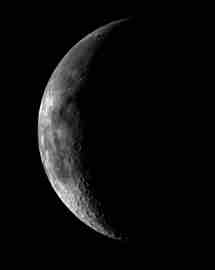The Galileo spacecraft obtained this image of the crescent moon. The smallest features visible are 8 kilometers (5 miles) in size.
Click on image for full size
NASA/JPL
The Youngest Crater on the Moon
News story originally written on December 30, 2002
Astronomers may have found the Moon's youngest crater! Created in 1953, the crater is believed to be the only one formed in recorded history.
In 1953, a flash was seen on the Moon, probably from the impact of a small asteroid, and Leon Stuart, an amateur astronomer, took a photograph that provides the only definite evidence of the impact. At that time, our telescopes were not powerful enough to see the crater formed by the impact, but now researchers, who are examining images from orbiting spacecraft, have found a small new crater in the same position as the flash.
Based on the 1953 photograph of the impact, the object that struck the Moon was probably about 300 meters across and its impact would have made a crater up to 2 km in size according to Dr. Bonnie Buratti of the NASA Jet Propulsion Laboratory, and Dr. Lane Johnson of Pomona College. If the object had struck the Earth instead of the Moon, it would have destroyed an area the size of a large city.
Images of the Moon from the Clementine mission show a 2-km-wide crater surrounded by a bright blue blanket of fresh lunar sub-soil at the exact location of the 1953 flash. According to scientists, this new small crater may be one of many. They believe small craters may be formed on the Moon every few decades, but this is the first one to have been found.
Last modified February 24, 2003 by Lisa Gardiner.
You might also be interested in:

It was another exciting and frustrating year for the space science program. It seemed that every step forward led to one backwards. Either way, NASA led the way to a great century of discovery. Unfortunately,
...more
The Space Shuttle Discovery lifted off from Kennedy Space Center at 2:19 p.m. EST, October 29th. The sky was clear and the weather was great as Discovery took 8 1/2 minutes to reach orbit for the Unitied
...more
A moon was discovered orbiting the asteroid, Eugenia. This is only the second time in history that a satellite has been seen circling an asteroid. A special mirror allowed scientists to find the moon
...more
Will Russia ever put the service module for the International Space Station in space? NASA officials are demanding an answer from the Russian government. The necessary service module is currently waiting
...more
During a period of about two days in early May, 1998, the ACE spacecraft was immersed in plasma associated with a coronal mass ejection (CME). The SWICS instrument on ACE, which determines unambiguously
...more
J.S. Maini of the Canadian Forest Service has referred to forests as the "heart and lungs of the world." Forests reduce soil erosion, maintain water quality, contribute to atmospheric humidity and cloud
...more
In late April through mid-May 2002, all five naked-eye planets are visible simultaneously in the night sky! This is includes Mercury which is generally very hard to see because of its proximity to the
...more















